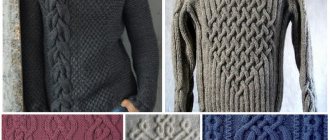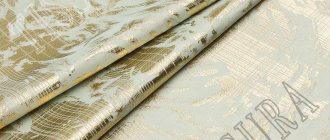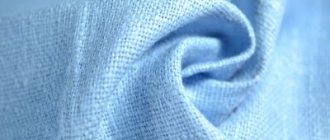Inexperienced seamstresses often encounter an annoying problem: a product that, after manufacturing, fits perfectly to the figure, becomes too small after the first wash because the fabric has shrunk. Sometimes the degree of shrinkage is insignificant, and sometimes the thing turns out to be hopelessly ruined - it shrinks so much. To protect themselves from such surprises, experienced needlewomen use a technique called decating.
What is the essence of the process?
Decatting a fabric is treating it with moisture and heat before cutting. That is, forced sitting down. However, do not confuse decatification with washing: they are not exactly the same thing (and sometimes not the same at all). But if you know certain subtleties, it won’t be difficult.
Before cutting the product, you should keep in mind that some types of textiles can shrink up to 8 cm per meter. That is, after the first wash, the product will become two sizes smaller!
Wet-heat treatment before cutting and sewing not only forces the fibers to shrink, but also relieves their tension, that is, stabilizes them. This means that such a product will be less deformed. For colored fabrics, you can additionally fix the color.
The decatification regime, as well as washing and ironing, depends on the composition of the textile. The following processing is required:
- fabrics containing from 50 to 100% natural fibers;
- fabrics with a rare weave of threads (for example, boucle);
- textiles with an admixture of elastane;
- lining;
- cushioning materials of any composition.
When carrying out processing, it is important to apply several rules:
- ironing is carried out only on the wrong side;
- the iron moves only in the direction of the warp threads (lobar);
- You cannot dry textiles on a rope - a folding dryer, a crossbar or a stick will do;
- the fabric is soaked (or even washed) if the finished product is planned to be washed;
- If the item will be dry cleaned (suits, jackets, coats), steaming with an iron is sufficient.
Do not wash fabric if its label indicates that it has been treated with a special impregnation (antistatic, dirt-repellent, anti-crease, etc.). Make do with steaming.
Possible defects
Any garment will need to be refreshed after wearing. But even hand washing can cause fabric to shrink. Exposure to hot water is the main cause of size reduction. If this happens when the product is sewn, it will be impossible to wear it.
When sending clothes or material to the automatic machine, set the temperature to 35-40°. Basically, shrinkage manifests itself as a decrease in linear size along the lobar, but in some cases both length and width are shortened. To prevent this phenomenon, decating is carried out at weaving factories, but at home it would also not be superfluous to carry out an additional procedure, in order to be on the safe side.
We process correctly
The decaling of natural, artificial, synthetic and mixed fabrics is different. The higher the percentage of natural fiber, the more “aggressive” the processing should be.
Do not neglect home decalcification if there is a note on the material’s label that it has already been done industrially. Better to play it safe.
How to decatify different fabrics?
- Textiles made from cotton and linen are first “shocked”: immersed in hot and then cold water. There is no need to intensively twist or wring out the fabric, otherwise “stubborn” creases will form. It is enough to squeeze it lightly, dry it and iron it slightly damp. If such textiles have a bright color or pattern, adding vinegar to cold water (a spoon per liter) will help fix the color. When ironing, it is important to protect the surface of the ironing board with thick white material: cotton textiles often shed heavily. If colored marks remain on the protective fabric, the product will have to be washed separately from other items in the future.
- Calico is treated in the same way, since this fabric consists of natural cotton fiber.
- Staple decatification begins with soaking in hot water (up to 14 hours). It is convenient to do this at night. Then you need to squeeze it lightly, let the water drain, but do not dry it too much, but dry it with a hot iron.
- But for viscose, long-term soaking is not suitable, since it can cause the fibers (and this is cellulose) to swell greatly. 20 minutes in warm water is enough. Then the viscose needs to be dried and ironed from the inside out in the “Silk” mode.
- Processing of natural silk consists of “wet wrapping”. The textile piece is wrapped in a damp sheet (preferably white, to prevent “mutual shedding”) and allowed to lie for a couple of hours. Next, the silk is dried a little and ironed with a semi-damp iron from the inside out in the “Silk” mode. Since natural plain silk often leaves unsightly stains from water droplets, ironing should be done without steam.
- The artificial silk is left for 15–20 minutes in warm water, adding a little salt to it - this will help maintain its shine. Then squeeze a little and wrap in a dry white sheet for 3 hours. At the end of the procedure, the artificial silk is dried from the inside out with an iron, being careful not to stretch it too much.
- Woolen and wool-blend textiles are not soaked. It is either wrapped in a damp sheet for 10 hours, or sprayed from the inside with water from a spray bottle and left to lie (up to 12 hours), depending on the thickness of the wool. Thick, coarse material is wrapped in a sheet moistened with a solution of water with salt (teaspoon per liter) and vinegar (tablespoon per 2 liters), thin material is sprayed. After this, the fabric is carefully steamed with a hot iron, always through an ironing iron (otherwise unsightly lasses may remain), trying not to pull the iron, but carefully rearrange it in the direction of the grain thread.
- Decating knitwear and chiffon is not so clear. They are produced with different fiber compositions. Therefore, the processing option must be selected based on it. Since chiffons are thin and light fabrics, they can be lightly treated with gelatin to make cutting easier (the chiffon will warp less) as well as sewing (gathering at the seams is prevented). Knitwear consisting of synthetics practically does not shrink. For it, damp ironing from the inside out is enough. If decatification by washing is planned, the knitwear is washed with baby shampoo on a delicate cycle in a special laundry bag.
- You just need to wet the cushioning fabrics for decating in warm water and let them dry, after removing excess moisture with a terry towel.
- The lining material is also moistened with warm water, lightly wrung out, allowed to dry and ironed semi-damp. Or spray and iron dry.
- There is no need to remove non-woven fabric, synthetic padding, adhesive auxiliary materials, natural and artificial leather, crinkled fabrics, varnish, pile materials (velvet, corduroy, velor), bologna.
If decating is carried out by washing, you must first treat the sections of the material with an overlocker so that they do not fray or crumble. This is especially important for very loose fabrics.
Decating is not such a complicated process. But if it is done correctly, the future product, already at the cutting stage, is insured against the fact that it will be small in finished form. Unless, of course, there are errors in the calculations.
Reasons for shrinkage
Shrinkage is a change in the size of fabric under the influence of moisture. The product may shrink not only in direct contact with water or steam, but also under the influence of precipitation or high air humidity. True, in these cases the process does not occur so quickly and the clothes do not have time to become greatly deformed.
Fabrics can shrink at various stages of production: during cutting, sewing, or even during storage if it is not carried out properly. As a rule, in these cases, the amount of deformation is provided and taken into account when sewing products.
A much greater nuisance is the shrinkage that occurs during clothing use, since it is not possible to cope with it in all cases. The reasons for changes in the size of products after wet-heat treatment are as follows :
- The appearance of reversible elastic deformation. During the textile production process, the threads of the fabrics are subjected to repeated stretching, as a result of which they are, as garment workers say, “under tension.” During the dyeing stages, to ensure maximum impregnation, the materials are pulled onto special spreaders, and so-called elastic deformation appears in the product.
During the first wet-heat treatment, the tense fibers are weakened and the fabric shrinks. Moreover, in most cases, the product decreases more strongly in size not along the weft threads, but along the warp threads.
- Swelling of threads. By absorbing moisture during washing, soaking or steaming, fabric fibers also relieve tension. At the same time, they not only shorten, but also bend, as a result of which the clothes take on bizarre shapes. This process is especially strong in knitted fabrics.
Shrinkage is a very unpleasant phenomenon that requires extra costs from manufacturers. When cutting materials, craftsmen are forced to make allowances, which increases fabric consumption and does not always lead to the desired results.
The degree of shrinkage distinguishes not only different fabrics, but also the same material in different parts of clothing, depending on their size, the shape of the patterns and the number of stitches. Thus, small parts with frequent seams, for example, sleeves, collars or pockets, “shrink” more than large panels.
It happens that when sewing mixed fabrics that are not subject to changes in size, cotton threads are used. As a result, after washing, the product gathers unattractively at the seams and loses its attractive appearance.
How to eliminate shrinkage
In order to prevent the finished product from shrinking, before washing or ironing, you need to carefully read the composition of the fabric and the care instructions, which are located on the label in the form of icons. If a sweater, jacket or dress is already deformed, then you can try to return it to its original size. Experts recommend using the following methods:
- The textiles are soaked in cool water for 1-2 hours, and then lightly wrung out and laid out on a flat surface. To prevent drying quickly, cover the product with a terry towel. The shrunken parts are stretched and secured with clothespins. As it dries, the clamps are rearranged, increasing the tension.
- You need to mix equal amounts of water and ammonia. Leave the clothes in the solution overnight, then wring out, stretch and lay out to dry.
- If the degree of shrinkage is insignificant, then you can do without water. The product must be ironed through cotton fabric with a hot iron in steam mode. In this case, deformed parts should be straightened from time to time.
- Jeans that have shrunk after washing can be restored to shape by washing them in cool water and then drying them by running a hot iron along the inside in the direction of the desired stretch. When the fabric is only slightly damp, you need to put on the trousers and sit down in them several times. After this, your favorite pants will return to their original size.
Interesting to know! There is another way that will help save a thing that has become stuck. Put a damp and slightly dried sweater or T-shirt on yourself and dry it in this form. After complete drying, the clothing will return to its original shape.
It is also worth mentioning that lost size can only be restored to fabrics that contain cotton or synthetic fibers. Unfortunately, shrunken sweaters and cardigans made from 100% wool cannot be restored.
Developing rapidly, the modern textile industry pleases us with new beautiful fabrics every year. To avoid unpleasant moments that may arise during the operation of products made from them, you should carefully study all the properties of the materials.
Shrinkage of various fabrics
The amount of shrinkage of textile materials depends on several factors, including their composition. Fibers that shrink the most are those that can absorb the maximum amount of water and change their size when wet. Such fabrics include cotton and linen materials, as well as viscose.
The swelling of the fibers increases with strong twisting, which is very typical for wool and some silk fabrics. In this case, not only the diameter of the yarn changes greatly, but also the structure of the fabric itself.
There is a system of standards that provide for percentage shrinkage of various materials. Here are the values for the most common fabrics:
- Cotton: tartan, corduroy – 5-6%;
- Satin, chintz, poplin, percale – 3-5%;
- Linen fabrics – 6-7%;
- Wool blend – 3-4%;
- Wool – 6-7%;
- Silk smooth – 4-5%;
- Staple and viscose - 3-4%.
Interesting fact! When synthetic fibers are added to natural ones, their shrinkage ability decreases. But one should not think that synthetics are completely immune to this flaw. Even nylon products shrink up to 1.5% after washing, and semi-nylon products shrink up to 2.5%. Many cushioning materials, for example, dublerin and non-woven fabric, suffer from the same drawback.
Lifehacks from experienced tailors
Masters of their craft know how to properly prepare the material before cutting and save time and nerves.
- If the product wrinkles during ironing, the cut can be processed on the weight.
- To avoid damaging the fabric during water treatment, add 100 ml of vinegar to a bowl of water. Afterwards the fabric needs to be rinsed, starched and ironed. It will become brighter and softer.
- Not all knitwear is decatified. You can do just fine without this step: oil, jersey, diving.
- The wool is ironed through an iron made of chintz or calico. And in order for it not to lose its “marketable” appearance, you should not process it for a long time.
If you follow all the rules of decating, the result will pleasantly surprise you. Don't ignore the preparatory stages of work. This will make your outfit last longer.
Decatation of knitwear
Knitwear is soft, breathable and comfortable to wear. Outfits made from it fit well, do not wrinkle or lose their shape. It consists of synthetic, artificial and natural fibers. Before you start cutting it, you need to carry out several manipulations with water: carefully, but carefully.
- Wet the fabric in warm water.
- Wring out with a towel.
- Dry flat, placing a sheet underneath.
- Dry knitwear must be ironed from the inside out in the direction of the loop posts.
Decatting of this textile is important because the loop structure allows it to stretch in any direction.
- It is recommended to iron viscose knitwear at a minimum temperature without steam.
- It is better to soak cotton knitted fabric several times, since the natural material can “shrink” over several washes.
- It is enough to moisten woolen knitted blanks. You can first wrap it in a wet sheet, then iron it at a moderate temperature.
- If the composition contains more synthetics, then the compression of the cut will be minimal: an iron with a steamer is quite enough.
Seamstresses who are not afraid to take risks can wash delicate knitwear. Baby shampoo is good; for washing you need to choose the delicate or manual mode of the machine.
In any case, such fabrics require careful preparation before sewing. The more delicate the composition, the less time it takes to decatify.
Our store has a wide selection of knitted fabrics.











